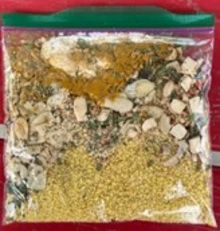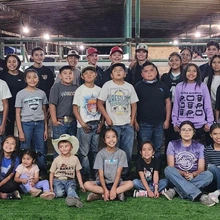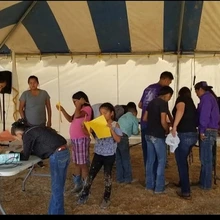4-H
Joseph Corbett
Backpacking is a very special endeavor considering we are seldom in situations where everything we need must be carried on our back. A backpacker has to be very judicious in what they choose to take on their adventure. Do they take a pillow? Should they bring their electric toothbrush? How much does biodegradable soap weigh? What should one bring to eat? How should food be cooked with limited supplies? In 2021, Tucson Village Farm’s Outdoor Leadership program devised a food system that gave campers autonomy over their meals, provided hot nutrient dense foods, created a safety center for adult oversight, was experiential by nature, and simplified the meal approaches.
Participatory Cooking: Learn by Doing

Figure 1: Example cooking kit with 2 portions of curry couscous
There is a growing wealth of literature around the benefits of getting young people outside. Time in nature and outdoors generally can support youth wellbeing through time spent restoratively, engaging in physical activity, and socializing (Wales et al., 2022). Time spent outdoors is also positively correlated with the 5Cs of positive youth development: competence, connection, confidence, character, and caring (Bowers et al., 2021). Backpacking trips are an example of outdoor adventure experiences which can foster adolescent wellbeing and positive youth development. Participating in this type of nature-based challenge with adult mentorship and among a group of peers gives youth a chance to develop new skills, build upon their self-esteem, foster relationships with each other, and build a sense connection and responsibility to the places they explore. One challenge in facilitating these experiences is making sure that youth get the healthy, nutrient dense food needed during a period of intense exercise while dealing with limits to pack weights and access to everyday amenities. It is also important that the activity be in accordance with the 4-H Motto, “Learn by Doing”. Although it can be much easier for an instructor to simply prepare meals, meal preparation during outdoor recreation presents a crucial opportunity for experiential learning. Given an active role, youth can engage in learning at every step of preparing for a backpacking trip from the selection, planning, and packing of meals ahead of time to the preparation and clean-up of their meals on site. Making the food planning and preparation processes participatory also supports youth in building the skills and confidence to become independent outdoor adventurers.
Cooking Kits: Preparing for the Trip
Backpacking camps with Tucson Village Farm (TVF) always start with one or two preparation days focusing on leadership development, trust, communication and other group dynamic skills. Supplies and food for the trip are also prepared.
Beginning in 2021, TVF pioneered a cooking kits system in which each meal is prepared ahead of an outdoor trip by portioning out dry and dehydrated ingredients into sealable plastic bags producing a ready to go “cooking kit” which can be cooked on site simply by mixing with boiling water in an insulated mug.
Using the cooking kits system, youth are brought into a role of responsibility in feeding themselves during their outdoor adventure. A key to this system is to have one pack, such as a climbing harness storage bag, that can hold all of the food for each camper. These bag styles are ideal because they have a clear panel for easy viewing. To make sure campers don’t mix up bags, each camper uses a name tag and writes their name on the outside of the pouch. This will be their personal food and food waste bag which they are responsible for throughout the trip. Each camper’s food bag will be packed with one (insulated, flat-bottomed) mug, one eating utensil, and enough snacks and meal kits for the duration of the trip.
Instructors plan in advance what meal and food options are available to participants while preparing for their backpacking trip. The kits should provide each camper with a bit more than 2000 calories per day. The recipe/meal options and ingredient options chosen for the trip should be written on a board or printed out for the campers to see and consider during the packing process. If a program looking to implement this system has access to farm or garden produce, these can also be dehydrated ahead of time for seed to trail cooking. It is advisable to have a staff member transport water to camping sites ahead of time, reducing pack weight.
- The process for packing food starts with everyone sitting around a large table. Everyone gets a bag, then start passing food around. Sidenote: TVF has tried to have “stations” where campers would move around the room, but found passing while seated to be easier, less confusing, and less messy.
- Begin with single item foods, such as granola bars or ramen packets. One person starts a product then passes it around the circle and everyone adds one granola bar to their bag. Even if the person doesn’t love that brand/type it is important that they take the quantity determined by instructors to ensure the group as a whole has enough food. TVF instructors like to advise campers that snack foods they don’t like are valuable bartering currency for the journey.
- Once the participants are comfortable with the passing and packing process, begin preparing meal kits. For each meal, pass around a mesh/sealable plastic bag and then the ingredients. Campers can customize their meals by choosing which ingredients they want and measuring out the amount of food (starting from a base minimum) that they think they’ll need. For example, when preparing a meal kit for curry and rice each camper might have to measure out and add a minimum of 1/4 c minute rice and 3 types of dehydrated vegetables, but they can choose to add more rice or vegetable types and can choose what vegetables and spice mixes they want to add.
- Once all ingredients are added to the meal kit bag, seal it up and add it to the camper food pack. Continue the process to make enough meal kits for the duration of the trip.
Recipe Examples
Makes enough for 2 meal kits. Cook with 1 c boiling water. Add salt to taste.
Backpacking Spanish Rice and Beans
1 c rice, Minute Rice
¼ c beans, dehydrated
½ tsp smoked paprika
1 tsp chile powder
1 tsp cumin
½ tsp oregano, dried
1 TBS dehydrated vegetables
Backpacking Curry CousCous
½ c couscous
2 tsp curry powder
½ tsp ginger
1 tsp peanut butter powder
1 tsp coconut shreds
1 tsp soy powder
2 tsp coconut powder
1 TBS mushrooms, dehydrated
1 TBS chives
1 TBS soup veg
1 TBS almonds
1 TBS TVP (texturized veg protein)
Food Autonomy, Communal Experiences
The meal kits system is also unique because it promotes food autonomy for the young people while maintaining the communal food experiences which make outdoor adventures so special. Rather than camping experiences where youth cook but instructors still dictate the menu, the meal kits allow youth full autonomy over their food during the trip. This is not always a common experience for youth in their day-to-day lives and it has proven meaningful for many campers. During the preparation of meal kits youth can choose for themselves which recipes they want to use and which ingredients to add. Campers report that it’s an exciting experience to plan their own meals for the trip and they get very creative. This setup also saves instructors the work of trying to predict the food participants will enjoy most. Sitting in a circle to pack their food bags is still a communal experience and encourages conversation and bonding ahead of the trip. While on the camping trip, youth get to choose which meal kit they want to cook for themselves, but they still cook and eat together. This level of autonomy also provides the learning opportunity for youth to tune into their bodies and determine for themselves their needs at any given time. For instance, whether they’re craving something sweet or savory in that moment.
References
Bowers, E. P., Larson, L. R., & Parry, B. J. (2021). Nature as an Ecological Asset for Positive Youth Development: Empirical Evidence from Rural Communities. Front. Psychol. 12:688574. doi: 10.3389/fpsyg.2021.688574
Wales, M., Mårtensson, F., Hoff, E., & Jansson, M. (2022). Elevating the Role of the Outdoor Environment for Adolescent Wellbeing in Everyday Life. Frontiers in psychology, 13, 774592. https://doi.org/10.3389/fpsyg.2022.774592
Pagination
- Previous page
- Page 4
- Next page





